Metro Access
The Muni Metro light rail system features six lines: the J Church, K Ingleside, L Taraval, M Ocean View, N Judah and the T Third. These lines serve downtown and neighborhoods in the western and southeastern parts of San Francisco. Below is more detailed information on the accessible features in our Metro system, how to board in the subway, how to board on the surface, and some additional tips for using the Metro.
Step-by-step instructions
Accessible Features
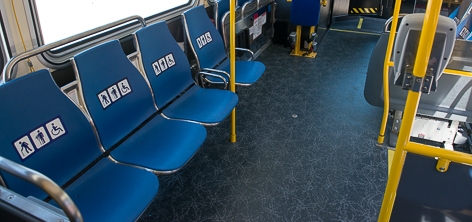
Priority Seating
Priority seating for seniors and customers with disabilities is located immediately behind the train Operator’s compartment at both ends of the car. The priority seating includes the first rows of aisle-facing seats, which flip up to accommodate a wheelchair, and the first rows of forward-facing seats.
Please Note:
On crowded trains, the priority seats may already be occupied by seniors and people with disabilities or by other customers. Upon request, operators can ask passengers to give up their seats, but cannot force them to do so.
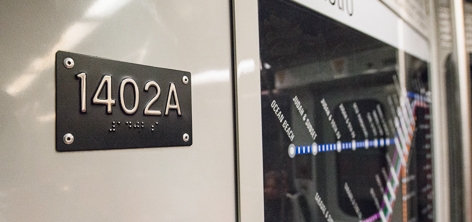
Vehicle Identification Number Plate
All vehicles have a vehicle identification number plate at each end that includes four digits plus the letter A or B to denote the end of the vehicle. The signs are located approximately 60" from the floor on the flat panel behind the Operator’s compartment and include raised characters and braille. Customers must provide the vehicle number in order to report problems with equipment or service.
Push Button Intercoms
Vehicles are equipped with push button-activated intercoms, to be used in case of emergency, which allow customers to communicate with the train Operator. The intercoms are located next to the door behind the Operator’s compartment at each end of the car.
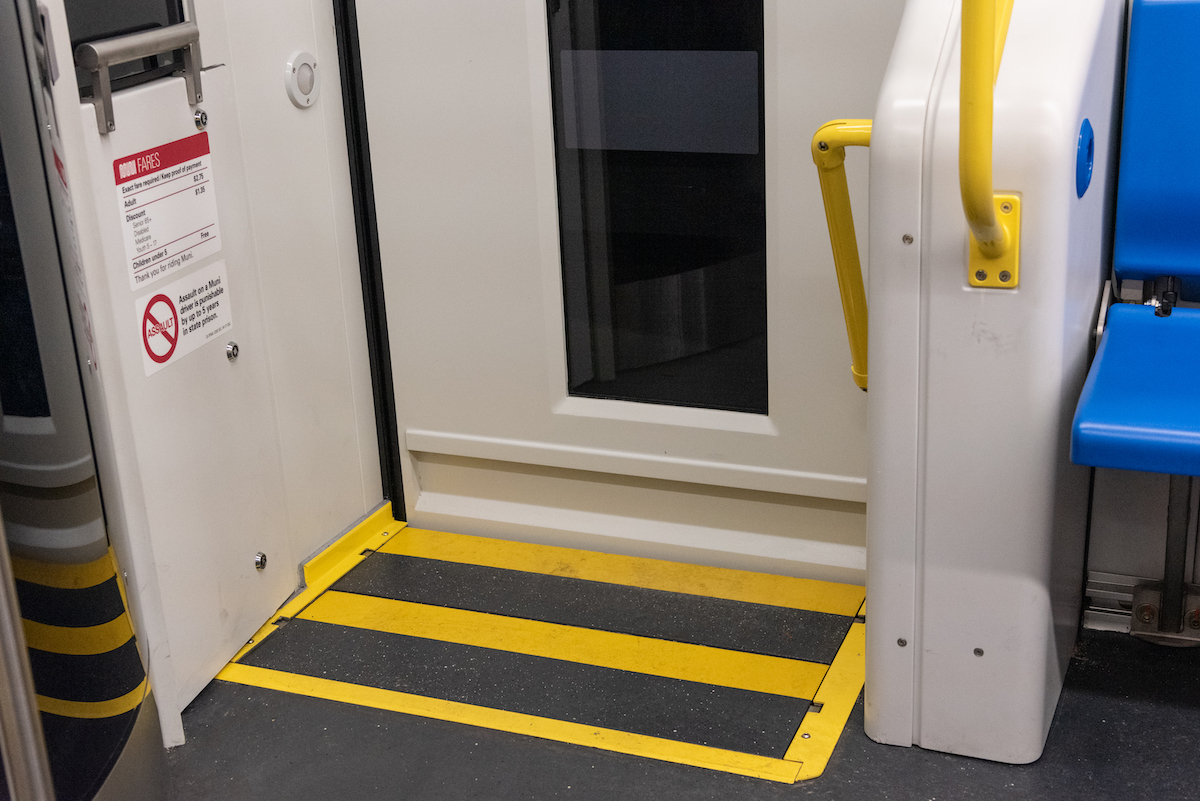

Stairs Can Be Raised or Lowered
The stairwells on all of our LRVs can be raised or lowered. For street level stops on the surface, these steps are kept in the lowered position. For stops at high level platforms the stairs are raised. A bell sounds when the steps are lowering to warn passengers to move away from the doors. At high level platforms, step extensions, which deploy automatically when the doors are opened, are used to reduce the gap between the LRV floor and the station platform.
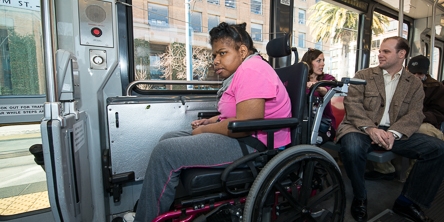
Dedicated Area for Mobility Devices
Each LRV is equipped with four flip-up seating areas near the front and rear of the train car. These seats can be flipped up to accommodate most mobility devices. If you are concerned about whether your mobility device can be accommodated, please contact SFMTA Accessible Services (415.646.2260).
Segways
Muni may be able to accommodate a Segway, when used as a mobility device. You will need a Permit. For more information on Segway accommodations, please call or contact Matthew West (415) 646-2753, or Matthew.West@SFMTA.com.
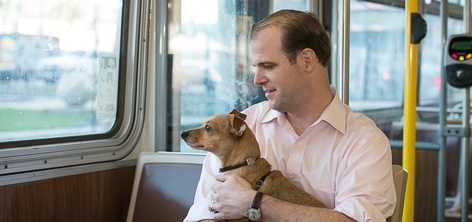
Service Animals
Service Animals are allowed on the Muni Metro. Service animals must be leashed and under the control of their owner at all times.
More Information:
In the Subway
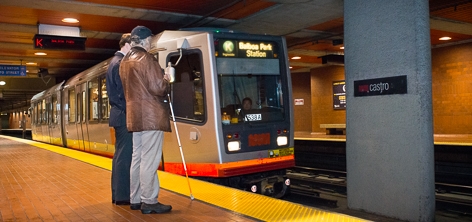
Overview
The Muni Metro stations from West Portal to The Embarcadero are underground. The downtown subway stations (between Civic Center and The Embarcadero) are shared by Muni and the Bay Area Rapid Transit District (BART). These stations are multi-level, with a concourse level, a Muni boarding platform at mid-level and a BART platform at the lowest level. Downtown stations are identified by distinctive print signs and braille signs.
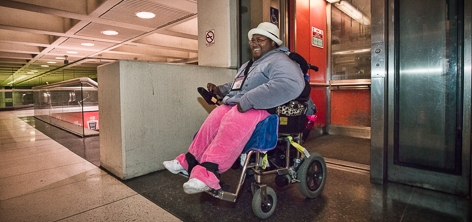
Elevators
All underground stations are accessible by elevator. The street level elevators at each station are located on the north side of Market Street near a station entrance and are marked by a sign. The street elevator will take you to the concourse level, where signs are posted to direct you to the platform elevator. At the concourse level of the shared downtown stations, Muni and BART have separate and distinct station agent booths and faregate arrays. A shared elevator provides access from the concourse to both the Muni and BART platform levels. For information on elevator status, please call the San Francisco Customer Service Center at 311 (415.701.2311 outside of San Francisco). You may also contact BART’s elevator information line at 510.834.LIFT (510.834.5438) or 888.235.3828. Elevator alerts can be texted to your phone by signing up for "Watch Route Alerts" and choosing to receive alerts for either the J, K, L, M, N or T Lines (text message rates apply).
More Information:

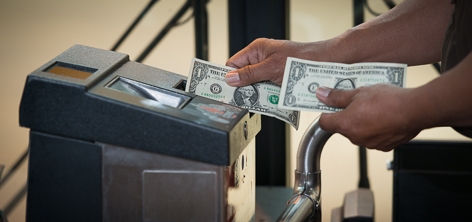
Paying Your Fare
You must pay your fare prior to boarding the elevator to the platform. Passengers are encouraged to pay with a Clipper Card by tagging the card at the Clipper reader near the elevator to the platform. Passengers who are eligible to pay a discounted fare but do not have a Clipper Card or transfer must purchase a ticket from a ticket vending machine near the station agent booth. The ticket must be tagged at the Clipper reader on the concourse level near the elevator in order to serve as valid proof of payment.
More Information:
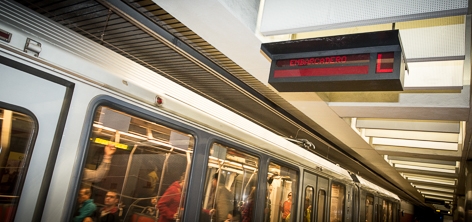
On the Station Platform
Once on the Muni platform of a shared station, signs will direct you to the inbound or outbound side. Look for the red “boarding area” signs on the trackside walls (opposite the platform waiting area) that indicate where to wait for a train. On the platform, overhead digital signs display the line name and destination of the train that is boarding as well as the next train pulling into the station. A recorded voice also announces the predicted arrival time of the next three trains in the subway. Metro maps are installed on the trackside walls and tactile maps of the entire Muni system are located on the subway platforms at the inbound and outbound boarding areas.
On the Street
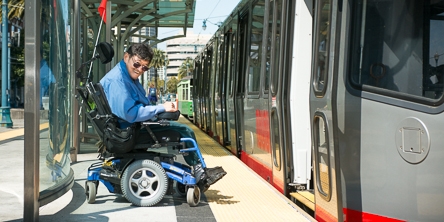
Access for Mobility Devices
Accessible stops for wheelchairs and other mobility devices are located at regular intervals and at major destinations such as schools and hospitals. Accessible surface stops are generally low-level island stops with a ramp up to a small high-level platform for those who need level boarding.
On the T Line all surface stops are wheelchair accessible, with high platforms that provide level boarding at all doors. There are ramps at one or both ends of these platforms. On the M Line, the platforms at Stonestown and San Francisco State are also high-level platforms.
More Information:
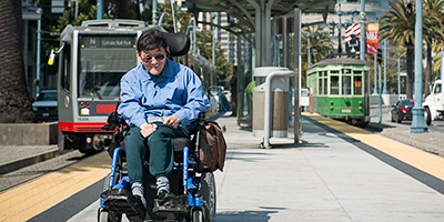
Boarding from an Accessible Island Stop
To board from an accessible island stop, wait for your train on the high platform. When the train arrives, the Operator will raise the interior stairs and position the vehicle so that you can board at the first door. Let the Operator know your destination stop as soon as you board and whether you need help with the jump seats at a stationing area. Wheelchair users should then proceed to the wheelchair stationing area, which is created by flipping up one of the first sets of aisle-facing seats next to the door.
Note:
When traveling from downtown to a street level destination on the J, K, L, M or N lines you MUST board the first door of the first car of the train. Be sure to let the Operator know your destination in advance so that they can properly position the train at the accessible platform.
Boarding at San Jose and Geneva Ave.
On the M Line, the accessible stop at San Jose and Geneva avenues has a mechanical wayside lift that elevates customers to the level of the train floor for boarding and exiting. The lift is separated from the boarding island by a gate, and remains in the lowered position when not in use. To use the lift, go through the gate and wait for a train on the lift platform. Locate the control button (on your left when facing the train). When the LRV arrives, push and hold the “up” button to raise the lift. Press the button continuously or the lift will stop. If you are unable to press and hold the button, the train Operator can raise and lower the lift from inside the train. Note that the lift will not operate until the train stops next to the platform.
Note:
When traveling from downtown to a street level destination on the J, K, L, M or N lines you MUST board the first door of the first car of the train. Be sure to let the Operator know your destination in advance so that they can properly position the train at the accessible platform.
Our lifts can lift up to 600 pounds. The securement area is limited by dimension. If you are concerned about whether your mobility device can be accommodated, please contact SFMTA Accessible Services (415.646.2260).
Additional Tips for Using the Metro
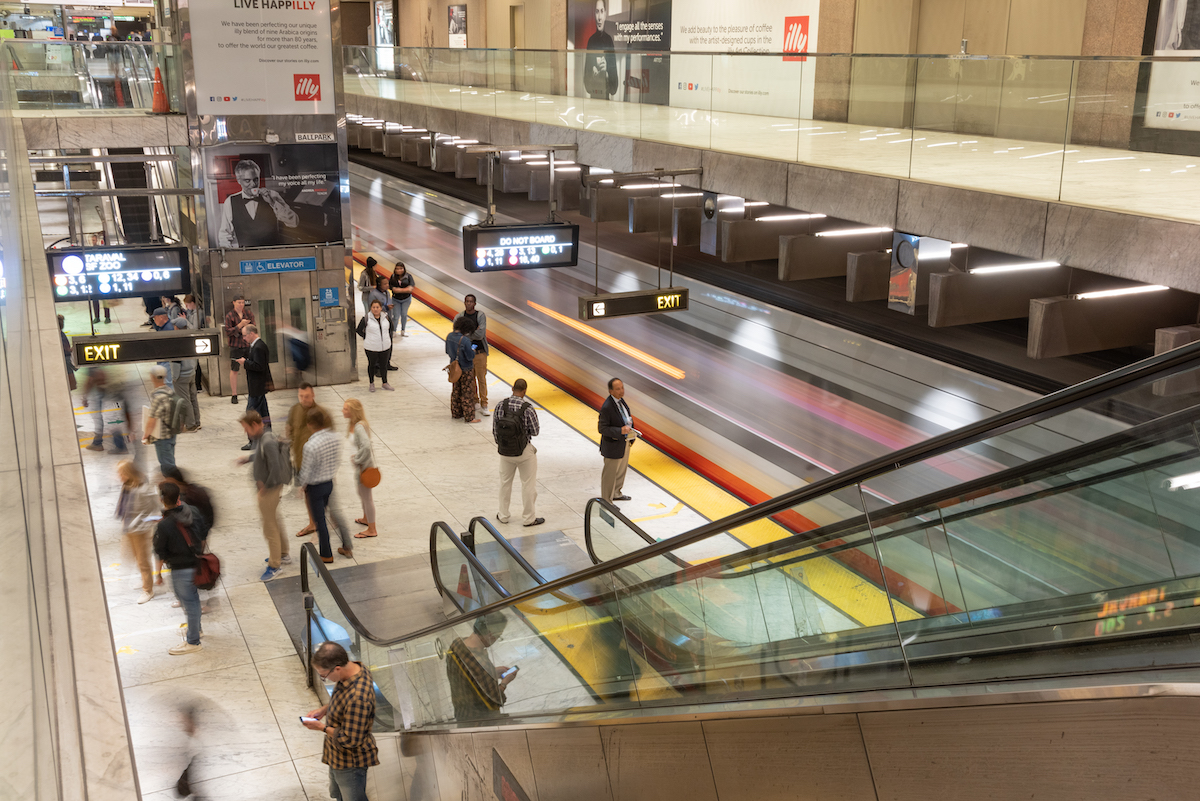
Underground Stations
All underground station entrances are easily identified by sidewalk signage. They also have Braille station name signs, often on the right-hand side of the stairwell. All subway stations are accessible by elevator, escalator or stairs and comprise of two levels, a concourse and a platform level. An accessible fare gate is available for use and is located immediately adjacent to the station agent booth.
Yellow tactile tile is provided on the platform level to indicate the edge of the boarding platform; please stand behind the tactile tile at all times while on the boarding platform.
Stations are either center platform (tracks on either side) or side platform (two platforms with tracks in between).
Center Platform Locations
- Embarcadero
- Montgomery
- Powell
- Civic Center
- Van Ness
Side Platform Locations
- Church
- Castro
- Forest Hill
- West Portal
Automated Announcements
In the underground stations (Embarcadero, Montgomery, Powell, Civic Center, Van Ness, Church, Castro, Forest Hill and West Portal), a digital voice announcement system announces the route designation and arrival time of approaching and arriving trains. Announcements of upcoming stations are made inside the train.
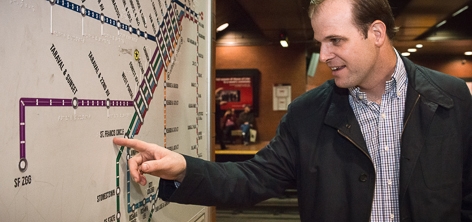
Tactile Maps
Maps of the Metro system with Braille and raised characters are installed on the concourse and platforms levels of underground stations. Braille and Tactile Maps of certain Muni Metro lines are also available from the San Francisco Lighthouse for the Blind; more information on this program can be found here.
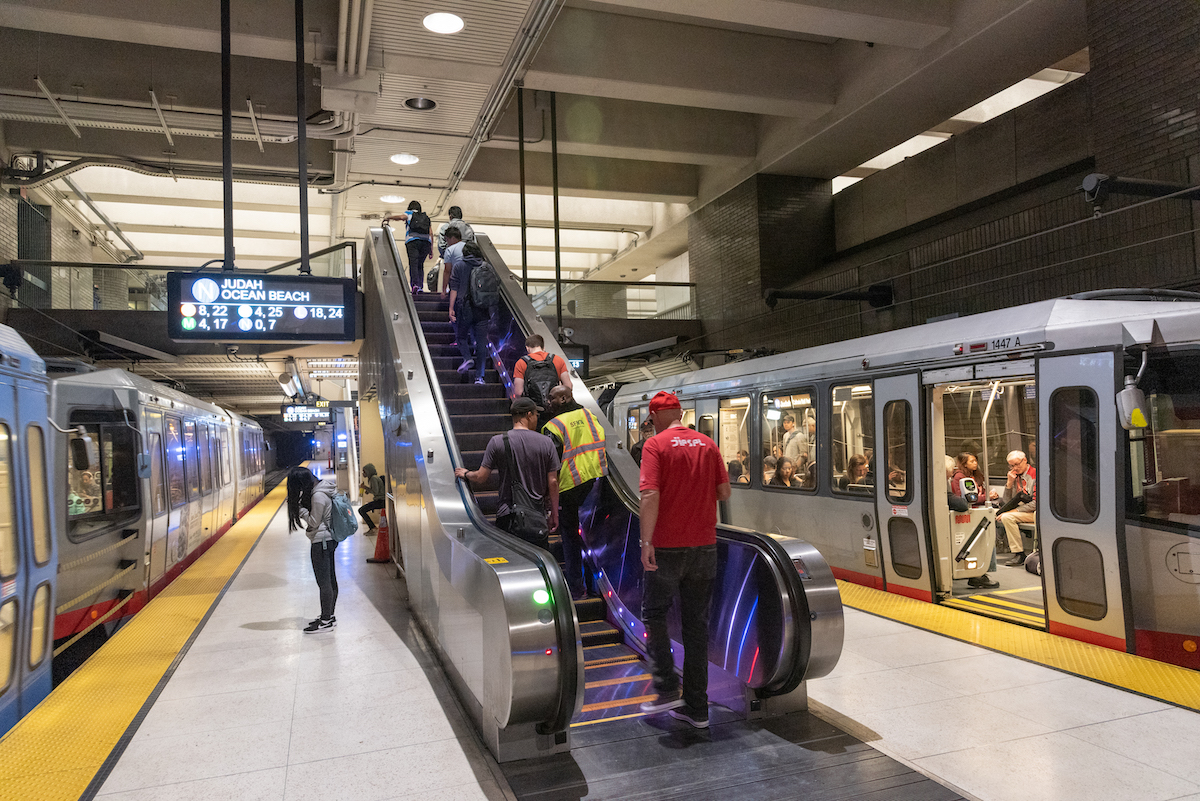
Stair and Escalator Locations
Stairs and/or an escalator are located at each end of every downtown station. Inbound trains stop near the middle of the platform and outbound trains stop at the far end of the outbound platform.

Boarding and Exiting a Train
Metro cars are equipped with a chime that sounds in each doorway to help guide people with visual disabilities to the door opening.
Caution:
All light rail vehicles taper or narrow at each end, creating a larger vehicle-to-platform gap. When looking for a doorway, be sure to locate the floor of the train before stepping off the platform. Do not mistake the gap between the end of a car and the platform for the gap between the platform and the train doorway.
















